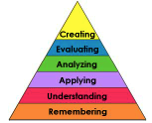Create a Standards-Based Integrated Performance Assessment Unit
Step-by-Step
Step 1: Review the Standards
The World-Readiness Standards for Learning Languages describe what students need to know and be able to do in broad terms, and are organized according to five Goal Areas known as the 5 Cs: Communication, Cultures, Comparisons, Connections, Communities. Take a few minutes to review the 5 Cs by matching the key phrases describing each standard to the appropriate C.
Drag and drop the key phrases describing each standard to the appropriate C. When dropped on the correct C, the phrase will stick; otherwise, it will return to its place.
For more information:
You can find the World-Readiness Standards for Learning Languages on the ACTFL website.
A learning module on the National Standards can be found on the CARLA website as part of the Content-Based Language Teaching through Technology project.
Standards Videoclip
Often when developing a unit of instruction, teachers focus on the Cs of Communication and Cultures. In order to create a complete learning experience for the students, it is important to also consider how Connections, Comparisons, and Communities will be represented in the unit.

As you watch the video
Note the examples that the teachers give, indicating how they integrate Comparisons, Connections, and Communities within their unit of instruction and assessment.
You may record your notes in the box below the video.
Examples of integration of Comparisons, Connections, Communities within a unit:
Both the Italian instructor and the Spanish instructor spoke about the integration of CONNECTIONS:
- Italian: History provided background information to situate the movie. Students learned about irony in English Language Arts and applied this concept to the movie.
- Spanish: Social studies provided background information on the explorers and the crops that were exchanged between the Old World and the New World.

After watching the video

Click to see example verbs for each level.
By Richard C. Overbaugh & Lynn Schultz
Old Dominion University
The teachers gave examples of the Connections they made within their units of instruction. If they had continued the discussion, what examples might they have given of Comparisons and Communities?
Since the focus of this video series is
on assessment, what sort of evidence could be used to document student learning and understanding related to Comparisons, Connections, and Communities? As you think about this question, think about how Bloom’s Taxonomy can give you and your students ideas about how to document learning for these standards.
Examples of Comparisons:
- Italian Cinema: Compare movie themes and plots, filming techniques between Italy and the US.
- Spanish Market: Compare shopping at an open air market to shopping in a grocery store.
- Chinese Geography: Compare landscapes in China to those in the US.
Examples of Communities:
- Italian: Invite community to view an Italian film (with subtitles).
- Spanish: Visit an open air market and/or Hispanic grocery store in the community.
- Chinese: Invite native speakers of Chinese from the community to class to share information about where they are from in China.
Potential evidence for Connections:
- Italian: In analyzing the movie, students could comment on how the time period was represented in the movie either in group discussions or in a written analysis of the movie.
- Spanish: Students could show on a map the foods that were brought from the Old World to the New World and vice versa.
Potential evidence for Comparisons:
- Italian, Spanish, Chinese: Students create a Venn diagram comparing US cinema, markets, geography to the target country.
Potential evidence for Communities:
- Italian, Spanish, Chinese: Document community experiences with journal entries, video, photos including reactions to the experiences, what was learned.
